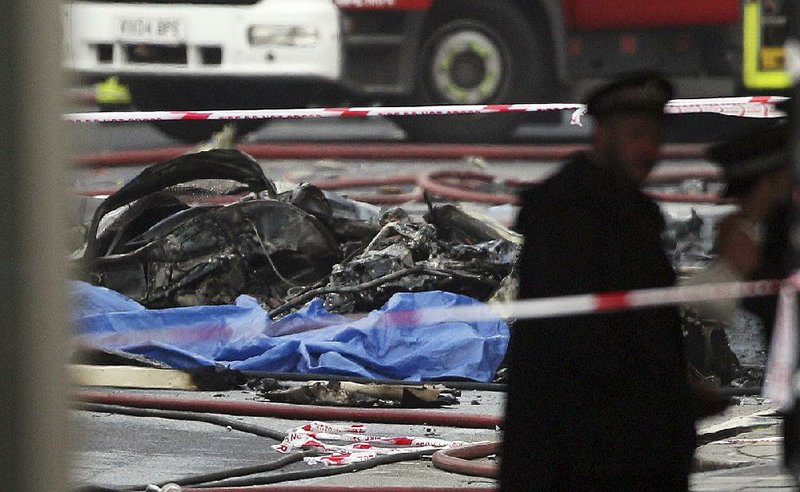LONDON — A helicopter crashed into a crane and fell on a crowded street in central London during rush hour Wednesday, sending flames and black smoke into the air. The pilot and one person on the ground were killed, and at least 13 others were injured, officials said.
The helicopter crashed in misty weather just south of the River Thames near the Underground and mainline train station at Vauxhall, and close to the headquarters of spy agency MI6.
Police said one person had critical injuries. Six were taken to a hospital with minor injuries, and seven were treated at the scene, ambulance officials said.
“It was something of a miracle that this was not many, many times worse,” police Cmdr. Neil Basu said.
The pilot had requested to divert and land at the nearby London Heliport because of bad weather, the heliport said in a statement.
“The London Heliport never gained contact with the helicopter,” the statement said.
The aircraft, an Agusta Westland 109, was on a commercial flight, said Philip Amadeus, managing director of Rotor Motion, an executive helicopter charter business.
The company identified the pilot as Peter Barnes, 50, whose career included flying in films including Saving Private Ryan and the James Bond movie Die Another Day.
“He was a very highly skilled pilot, one of the most experienced in the U.K., with over 12,000 flying hours,” Amadeus said. “We are devastated by the loss of a highly valued colleague and very dear friend.”
Police identified the other fatality as 39-year-old Matthew Wood, from south London.
The crash unfolded at the height of the morning commute when thousands of pedestrians in the area were trying to get to work. The weather at the time was overcast and misty with fog and poor visibility, according to the Met Office weather forecasting service.
Video from the scene showed wreckage burning in a street, and black smoke in the area, with a line of flaming fuel and debris marking the area where the helicopter smashed down. Witnesses said the disaster unfolded when the helicopter hit a crane atop a 50-story residential building, the St. George Wharf Tower.
“I was 100 percent sure it was a terrorist attack,” said Allen Crosbie, site manager for the landscape firm Maylim Ltd., who was working at the scene.
“There was debris everywhere, a ton of black smoke. Parts of the crane, parts of the helicopter. I heard bang, bang - I presume it was the helicopter hitting the crane and then the ground. People were just panicking.”
William Belsey, 25, a landscape worker, also said he heard the helicopter hit the crane.
“Luckily the crane operator was late for work this morning. He picked a good day to be late,” Belsey said.
Mayor Boris Johnson said the crane had been secured and was not in danger of collapsing.
British aviation authorities had issued a “notice to airmen” warning pilots about the crane, which extended to 770 feet above ground. The crane is lit at night, and police said investigators would look at whether the light was faulty.
The area, roughly 10 blocks from the major Waterloo train and Underground station, is congested during the morning rush hour. Many commuters arrive at the main line stations from London’s southern suburbs and transfer to buses or trains there.
Aviation expert Chris Yates said weather may have played a role. Investigators also would look at whether the crane had navigation lights.
“The question then becomes whether the pilot was fit,” Yates said.
Information for this article was contributed by Robert Barr, Danica Kirka, Jill Lawless, Gregory Katz and Paisley Dodds of The Associated Press.
Front Section, Pages 5 on 01/17/2013

